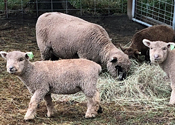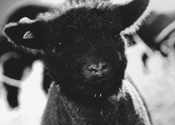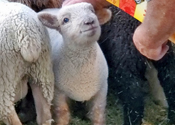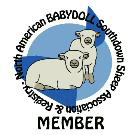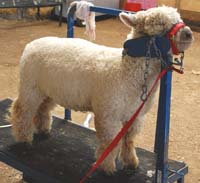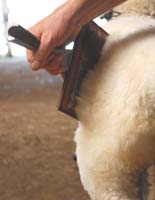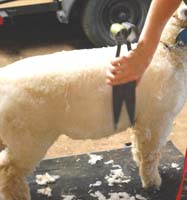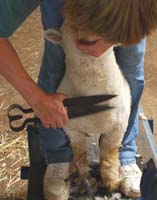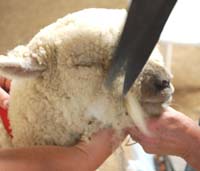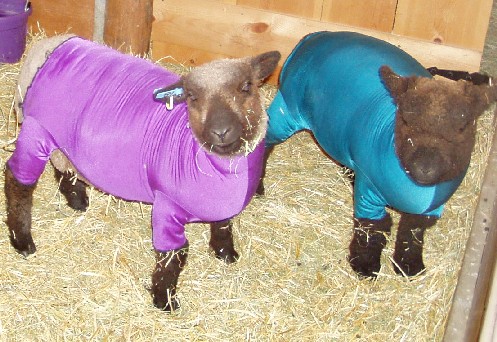SHOWING IN FLEECE
It can be beneficial to learn more about the show you plan to attend by picking up a rule book or meeting the Superintendent running the sheep show to learn the rules in your area. Attend a fair or sheep show and observe how the exhibitors are prepping their sheep. The sheep can look quite different in full fleeced/wool shows than they look in fitted shows. Both show types the sheep MUST be washed and/or clean. Sheep intended for breeding or grown for wool, like BABYDOLLS, are shown in full fleece. The idea behind fitted is it makes conformation and muscling obvious while leaving your sheep in fleece allows you to use wool to enhance these features. The staple length allows the sheep to be judged on the quality of its fleece. When showing in fleece it is very important to remember the sheep is to be washed and or be clean of debris, mud, stool, etc. The staple length for Babydolls ranges from 2.5 to 4” depending upon the color of the sheep. The black Babydolls tend to have a longer staple length but coarser fleece.
A couple weeks before the show wash your sheep, or long enough to allow the lanolin to get back into the fleece if you've used a shampoo that strips it out. Washing ahead of time helps with show day washing, cleaning, and prep. A blocking/show stand really saves your back and helps restrain your sheep. (Figure 1) Foamers work the best for even soap application or soap mixed with cold water. Sheep are rinsed from top to bottom, front to back. Be sure to completely rinse the soap out of the sheep or you will end up with a residue in fleeced sheep. Shammies are helpful to take the excess water out of the sheep after rinsing. A slicker brush can be used to take the knots out of the fleece. A currycomb is used to break down the fleece for easier carding. Be sure to deep card the fleece to facilitate the drying process and to help the fleece hold better form. If a blower is used, blow at an angle as to not knot the fleece. Card the fleece well before blanketing and placing sheep in a clean well-bedded pen. On show days, remember you do not want to strip the lanolin from the fleece if you're washing them. Any fitting you do remember to leave both enough staple length and lanolin to allow judging of fleece quality.
Two days before the show, or when the sheep are dry. Hold the hand card flat on top using a corner-to-corner action to pull and straighten the fleece. Carding is an important step to get a smooth fit on the sheep. It is also important not to rip card. It is painful to your sheep and will make the fleece uneven.Body: Make the belly sides flat. Either shear or clip the fleece off of the belly to give the impression of a long flat body. Blend the belly line. The belly should be slick shorn to 1/2" and the belly sides 3/4 to 1".
Legs: Card the rear legs and shape them to make muscling look large and blended. Finished leg fleece should be carded. A week prior to washing, trim the sheep’s hooves even.
Tail: The fleece on the tail nub should be cut short and makes a level cut to the bottom of the tail to make an impression of a wide and deep rear. A small narrow indentation line from bottom of tail (vulva in females) can be crutched out if needed to give a clean appearance to the back side.
Head, neck and shoulders: Card the fleece on the cheeks, muzzle, top of head, and ear set to make a level head set. Make sure the neck fleece blends into the shoulder fleece. These parts should all blend in well and not have any breaks.
SHOWING IN FITTED FLEECE
Sheep intended for breeding or grown for wool, like BABYDOLLS, are typically shown in fleece. See the SHOWING IN FLEECE SECTION ABOVE.
But when showing in fitted fleece it is very impressive to block-out, or cutout the wool leaving enough fleece for it to be evaluated by the judge. This is when you shear your sheep but leave fleece longer on the top line, butt, legs and poll. Top lines can be gradually fitted down a little at a time. The extra fleece allows you to accentuate your sheep's attributes. However, the goal is to level the tops and hips while giving the animal eye appeal from the side profile.
A couple weeks before the show wash your sheep, or long enough to allow the lanolin to get back into the fleece if you've used a shampoo that strips it out. Washing ahead of time helps with show day washing, cleaning, and prep. A blocking/show stand really saves your back and helps restrain your sheep. (Figure 1) Foamers work the best for even soap application or soap mixed with cold water. Sheep are rinsed from top to bottom, front to back. Be sure to completely rinse the soap out of the sheep or you will end up with a residue in fleeced sheep. Shammies are helpful to take the excess water out of the sheep after rinsing. A slicker brush can be used to take the knots out of the fleece. A currycomb is used to break down the fleece for easier carding. Be sure to deep card the fleece to facilitate the drying process and to help the fleece hold better form. If a blower is used, blow at an angle as to not knot the fleece. Card the fleece well before blanketing and placing sheep in a clean well-bedded pen. On show days, remember you do not want to strip the lanolin from the fleece if you're washing them. Any fitting you do remember to leave both enough staple length and lanolin to allow judging of fleece quality.
Two days before the show, or when the sheep are dry, fitting can begin. Hold card hand flat on top using a corner-to corner action to pull and straighten the fiber. (Figure 2) Carding is an important step to get a smooth fit on the sheep. It is also important not to rip card. It is painful to your sheep and will make the fleece uneven.
Top line: To cut the top out on a sheep with hand shears or electric shears, start at the high point of the loin and go out through the rump to create a level dock. Then a line is created from the top of the withers to the loin to establish a level top line. A good top line length when finished is 2.5 to 4” staple.
Body: Make the belly sides flat. Take extra off shoulders and front legs to give the impression of well laid in shoulders where many Babydolls are weak. Either shear or clip the fleece off of the belly to give the impression of a long flat body. Blend the belly line.
Legs: Trim the rear leg hair, then card the rear legs and shape them to make the muscling look large and blended. Trim inside of the front legs to make them appear straight. Trim the outside of the ankles to make the leg look straight. Trim the hooves even a week prior when washing.
Tail: The fleece on the tail nub should be cut short and level to make the impression of a wide and deep rear. A small narrow indentation line from bottom of the tail (vulva in females) to bottom of the twist should be made to accentuate depth of twist and to make the fitted legs look fuller.
Head, neck and shoulders: The fleece blended and the cheeks sheared to make the muzzle blend. The top of the head and the ear set blend in an almost level line. The neck blends into the shoulder. The brisket should be cut in flat on the bottom and straight down from under chin. (Figure 4) to make it broad and give the head set a good look.
The sheep should be carded and trimmed with hand shears and cutout a multitude of times until the desired look is accomplished. (Figure 5)
The end product is a straight-lined sheep with a similar line on the underline as the top line. Finish the finer details with a hand shearer for smoother finish. (Figure 6) To be a successful fitter one must card the sheep a lot. The only way to a smooth finished product without having cracks in your fleece on show day is to card. Lamb Jammies (Figure 7) can be used to help keep the fleece clean.
A NOTE ABOUT BIO-SECURITY

